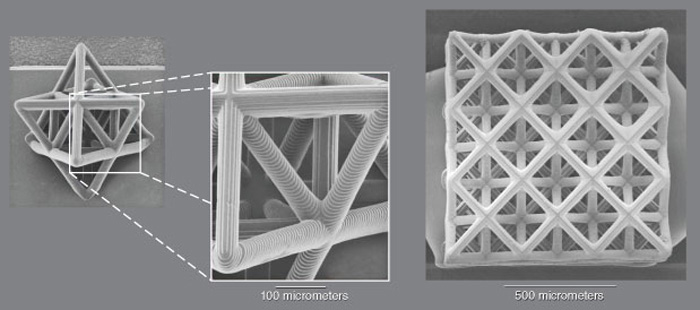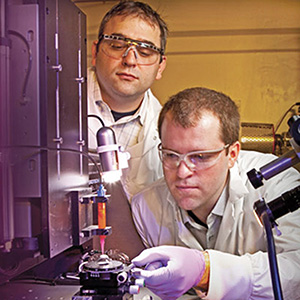The US Lawrence Livermore National Laboratory (LLNL), mostly funded by the Department of Energy, started so as to provide competition with the Los Alamos National Laboratory in 1952. The two labs have worked on similar projects since; first, beginning with the development of nuclear weapons. After the end of the Cold War, they sought to maintain existing nuclear capabilities and safely dispose of stockpiles. Now, both the New Mexico-based Los Alamos and the Northern California-based Livermore have found links with 3D printing. Sigma Labs, developer of the PrintRite3D in-process quality control system, was founded out of Los Alamos and continues work with them today. And, perhaps in competition with its older brother, Lawrence Livermore National Laboratory is cultivating 3D printing in its own Advanced Manufacturing Lab, pursuing material design, as well as parts and process certification.
At the moment, the lab is focused on altering the microscopic shape of a material, thus giving it unique properties. A materials scientist and engineer at LLNL, Eric Duoss, explained,

We can take the complexity of the design space and create microscale architectures that give you control over normal properties. We can take the same base material … and by changing the architecture of it, we can make it stronger, more lightweight and make it react differently to heat. With the design, you can control thermal expansion. We could design it so when it heats up, it actually contracts…The way the structure is set up, it can handle heat better or basically be a-thermal. On the land it can be one temperature, and in space another, but it will still hold its shape.
Scientists at the lab are able to simulate materials for creation using chemical models before the feedstock is fabricated. For instance, using projection microstereolithography, LLNL, in tandem with MIT, was able to 3D print an object made up of tiny octet trusses[1] to yield a lightweight structure with great rigidity. Modifying the underlying structure of a material could be of huge benefit for any industry. In terms of aerospace, for instance, speciality lightweight materials that withstand the heat of jet engines could make flying more efficient and cut fuel costs. Duoss adds, “It’s going to revolutionize manufacturing. It’s going to revolutionize it in terms of manufacturing itself. It’s about the ability to tailor properties and achieve property combinations that would have been previously impossible to create.”

And, though the ability to modify the structure of a material is certainly exciting, the lab is working on aspects of 3D printing that are essential at the moment. Namely, quality control and certification. In order to ensure that additive manufacturing is ready for the highly controlled automotive, aerospace and defense fields, LLNL is setting standards for both materials and processes. Diane Chinn, of LLNL’s materials engineering division, said, “We’re trying to make it less of an art and more of a science. We need to predict how the part is going to perform.” A group leader at LLNL’s Methods Department, Bob Ferencz, elaborated, “What are the stresses that build up in the part as the layers are added? As you melt new materials, the materials below are still being residually heated. How are those materials being affected by being heated again and again?”
The lab has begun a project called Accelerated Certification of Additively Manufactured Metals, which will develop predictive computer modelling for pre-print reliability. The models rely on physical principles virtually, with the actual prints used to test the accuracy of the software. In addition, LLNL is in the process of developing systems for in-process quality control, using 160 processors in conjunction with new code to analyze additive manufacturing at the microscopic level. LLNL engineer, Chris Spadaccini, describes how all of these techniques, in unison, will lead to more reliable printing processes, “Integrating modelling and design, material synthesis, and manufacturing, we can better tailor our solutions for specific applications and needs.” Ultimately, the certification process might be adopted by the larger AM community, so as to integrate the standardization methods into the manufacturing supply chain.
A non-profit local to Northern California, i-Gap, has used its partnerships with local businesses and institutions to promote such 3D printing advances to the public. The non-profit created a fab lab to connect to the local Maker community and educate them about the developments in 3D printing. The group is also a part of the California Network for Manufacturing Innovation (CNMI), which will give businesses the ability to use the advances coming out of LLNL.
In addition to the project announcement made by America Makes last week, it doesn’t seem long before industrial additive manufacturing will be up to snuff enough for large OEMs. The prospect of better quality control and new materials is exciting, but I still feel a chill every time I read about the close ties between government and industry. For instance, the story at the American Society of Mechanical Engineers (ASME) website covering 3D printing at LLNL has this to say: “While most of the LLNL’s computing capabilities were developed to support national security missions, a synergistic offshoot has been the application of HPC for science and engineering applications such as AM design.” With the environment on the brink of a total collapse, I really wish that that sentence read the other way around, with LLNL’s computing power developed to support science and engineering – particularly to fight climate change – over defense.
Source: Computer World, ASME
[1] This particular shape was developed by Alexander Graham Bell and Buckminster Fuller independently, with Fuller understanding how to employ geometric arrangements in ways that “do more with less”.


